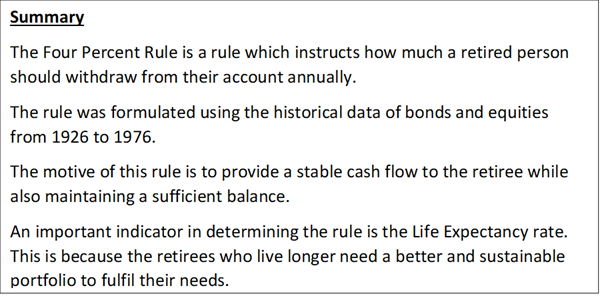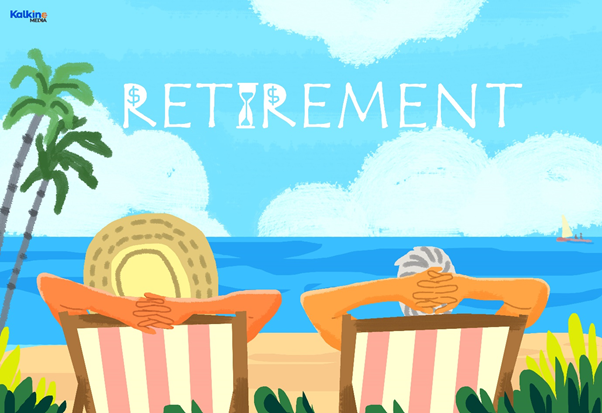What do you mean by the Four Percent Rule?
The Four Percent Rule is a general guideline used to decide how much a retired person should pull out from a retirement account every year. This standard tries to turn out a consistent revenue stream to the retired person while keeping a record balance that keeps pay moving through retirement. Specialists are divided on whether the 4% withdrawal rate is protected, as the withdrawals will essentially comprise premium and profits.

Source: Copyright © 2021 Kalkine Media
Understanding the Four Percent Rule
The four percent rule gives a directive to monetary organizers in setting a portfolio's withdrawal rate for their customers. A vital driver in deciding the rate is the life expectancy rate of that individual. The more they hope to live as retired folks, the more they will require their portfolio to help their way of life. A four percent withdrawal rate is an all-around tried number, even while expanding clinical costs in the last phases of life.
The four percent rule originates from chronicled information on stock and bond returns over the range of 50 years, between the times of 1926-1976. Before the 1990s, numerous people accepted that 5% was the fitting benchmark esteem that retired folks should've removed every year.

Source: Copyright © 2021 Kalkine Media
Through preliminaries and experience, many started to puzzle over whether 5% was excessively high. It prompted William Bengen, a monetary counselor, to direct a broad investigation of recorded returns in 1994. His examination included information from severe downturns between the times of 1930-1970. After many pressure tests, Bengen inferred that in any event, during financial downturns, a 4% withdrawal would not deplete a retirement portfolio for more than 30 years.
While a few retired folks cling to the Four Percent Rule to keep their withdrawal rate consistent, the standard permits retired folks to build the rate to stay up with inflation. Potential approaches to adapt to inflation incorporate setting a yearly increment of 2% each year, which is the Federal Reserve's objective inflation rate, or changing withdrawals dependent on real inflation rates. The previous technique gives consistent and unsurprising increments, while the last strategy all the more viably coordinates with pay to average costs for essential item changes.
The Four Percent Rule might be somewhat on the moderate side. As indicated by investment advisor Michael Kitces, it was formed to consider the most exceedingly awful monetary circumstances, for example, 1929.
It has held up well for the individuals who retired during the two latest monetary emergencies. Wellbeing is a vital component for retired people, regardless of whether following it might leave the individuals who retire in more settled financial occasions with a colossal measure of cash left unused, adding that all in all, a 4% withdrawal rate is very unassuming comparative with the drawn-out authentic standard return of practically 8% on a fair (60/40) portfolio.
Frequently Asked Questions
- What are the advantages and disadvantages of the Four Percent Rule?
While adhering to the Four Percent Rule can make it more probable that your retirement reserve funds will last the rest of your life, it doesn't promise it. The standard depends on the past execution of the business sectors, so it doesn't foresee what's to come. What was viewed as a protected venture procedure in the past may not be a protected speculation system later on if economic situations change.
There are a few situations wherein the Four Percent Rule probably won't work for a retired person. A severe or extended market slump can disintegrate the worth of a high-risk venture vehicle a lot quicker than a regular retirement portfolio.
Moreover, the Four Percent Rule doesn't work except if a retired person stays faithful to it throughout every year. Disregarding the standard one year to spend too much on a significant buy can have extreme results as it were, as this lessens the principal corpus, which straightforwardly impacts the progressive accrual that the retired person relies upon for supportability.
Nonetheless, there are clear advantages to the Four Percent Rule. It is easy to follow and accommodates consistent pay. If the method works out for a retired person, it will protect one from a lack of funds in retirement.
- When is the four percent rule ineffective?
The situations when the four percent rule isn't viable for retired folks are below:
- During a severe market slump or inflationary period.
- The compulsion to overdo it on significant buys. A retired person should stay steady and faithful to their pay-outs for the four percent rule to work. Flippant spending can prompt numerous helpless results later on. At the point when the principal reduces excessively fast, the self-multiplying dividends additionally diminish. Accordingly, leaving a more modest sum to support a retired person's arranged way of life.
- The rule is not very flexible. It assumes that the retiree will spend 4% annually without considering how the portfolio has performed.
- The rule also assumes those cases where the individual will have to spend more or less on the situation. Expenses fluctuate, and that is not taken into account.
- It takes an assumption that a portfolio has been equally invested in equities and bonds. The actual portfolio can differ from this theoretical assumption. Usually, retirees invest more in bonds than equities because bonds provide capital protection, and the downside risk is mitigated.
- The rule uses historical data for bonds and equities, which is not a solid indicator to imply the same will happen in the future. The rule also assumes a 30-year horizon which may not be likely for every individual.
- The rule also assumes that the portfolio will last for the next 30-years, which does not seem practical.
 Please wait processing your request...
Please wait processing your request...